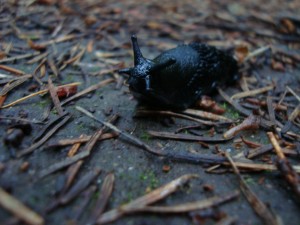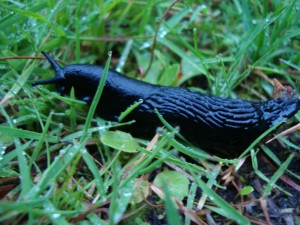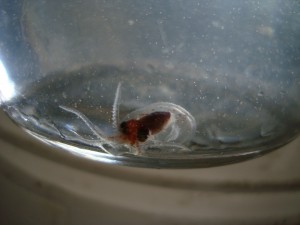
How can you resist that face?
Update on the sea star models: dough colors created from food color, flour, and lard are not matching the colors of real sea stars very well (particularly showing severely different reflectance in the UV, which birds can see), so I am performing predation trials with clay models again. But enough with the technical stuff.
After turning the car around only once to get something we forgot (cinnamon Life cereal), my research partner, Stephen Reller, and I set out on our journey to the Friday Harbor Laboratories on San Juan Island. A two hour drive up I-5 and a ferry ride later, we arrived and settled in by consuming an entire Digiorno pizza and retiring to our cabins.
The Friday Harbor Labs are run by the University of Washington, equipped with facilities for instruction and research year round by resident and visiting biologists. We were stationed in Lab 2 with access to a continuous wet-lab salt water source for our tanks of sea stars, boats for traveling to sea star site around the island, and plenty of other research students and professionals ready to talk science any time. The lab complex was also frequented by an abundance of wildlife. Deer, foxes, raccoons, otters, birds and slugs galore! I was particularly fond of the slugs, but Stephen was not.

Giant black slug at Friday Harbor Labs. What a beautiful gastropod.
Our days were divided between sea star surveys and my predation trials. For the surveys we traveled to a number of sites around San Juan Island and gathered data on the size, GPS location, color, mass, species, microhabitat, arm number, tidal height, and color spectrum of every single sea star we found. This made for a lot of turning over rocks and peaking into crevasses while trying not to slip on algae and tumble into the ocean. We had great success with the surveys, processing around 50 sea stars at each site and covering 5 survey sites. My predation trials did not go quite as smoothly, as there seem to be very few gulls on San Juan Island to try to entice with clay models, and those we did find seemed more interested in preening and chatting with their neighbors than foraging in the intertidal.
Still, despite this disappointment, I managed to enjoy myself. Most afternoons we spent basking in the island sun after a morning of field work. Evenings were divided between berry picking, cooking delicious dinners, reading, and occasionally setting up in-lad trials. I took advantage of our proximity to the water and swam nearly every day. I even took one Pacific dip at 10:30 pm in the pouring rain as the ferry hummed by. This was not the first time I have swum at night but, being from Alaska, this was the first time I have swum in the dark at night and it was both intensely creepy and wonderfully liberating. Though, Stephen didn’t appreciate the rain and assured me he was only their to carry the flashlight and refused the assume the role of life guard in the event that I was consumed by a night-time sea monster. Fortunately, we found no sea monsters, at least not hostile ones.
We did go “night-lighting” one night, which involves lowering a bright light into the ocean and night and waiting for the late crowd to show up. Mostly we attracted thousands of silvery minnows, which swam incessant counter-clockwise circles around our lamp, but there were a few special visitors. As the highlights we caught two baby red octopuses (including the one pictured below) and a larval crustacean which looked like an alien and stumped most of the researchers at the labs for an ID. After some digging, Professor Joel Elliott found that this particular crustacean was actually the inspiration for the alien from the original Alien movie, which would explain my earlier association.

Baby red octopus caught while night-lighting (lowering a bright light into the water at night) off the dock at Friday Harbor Lab. Approximately 1.5 cm.
We return to Tacoma June 15 and I will be sad to leave. The small town, the ocean, the motor boats, and the aliens make me sure I’ve chosen the right major in marine biology.
My hair is currently supposed-to-be-teal, which would probably be more accurately described as radioactive snot or some kind of Smurf mucous.
